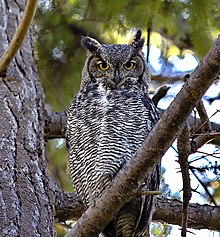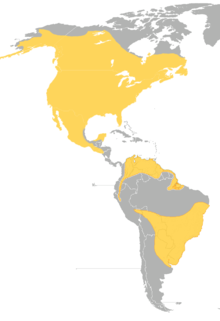| Great horned owl Temporal range:
| |
|---|---|

| |
| |

| |
| |
| Scientific classification | |
| Domain: | Eukaryota |
| Kingdom: | Animalia |
| Phylum: | Chordata |
| Class: | Aves |
| Order: | Strigiformes |
| Family: | Strigidae |
| Genus: | Bubo |
| Species: | B. virginianus
|
| Binomial name | |
| Bubo virginianus (Gmelin, 1788)
| |
| Subspecies | |
|
About 12, see text | |

| |
| Global range (all year) of B. virginianus | |
| Synonyms | |
| |
The great horned owl (Bubo virginianus), also known as the tiger owl (originally derived from early naturalists' description as the "winged tiger" or "tiger of the air")[3] or the hoot owl,[4] is a large owl native to the Americas. It is an extremely adaptable bird with a vast range and is the most widely distributed true owl in the Americas.[5] Its primary diet is rabbits and hares, rats and mice, and voles, although it freely hunts any animal it can overtake, including rodents and other small mammals, larger mid-sized mammals, birds, reptiles, amphibians, and invertebrates.
In ornithological study, the great horned owl is often compared to the Eurasian eagle-owl (Bubo bubo), a closely related species, which occupies the same ecological niche in Eurasia despite its notably larger size. The great horned owl is also compared to the red-tailed hawk (Buteo jamaicensis), with which it often shares similar habitat, prey, and nesting habits by day; thus the red-tailed hawk is something of a diurnal ecological equivalent.[6] The great horned owl is one of the earliest nesting birds in North America, often laying eggs weeks or even months before other raptorial birds.[7]
- ^ BirdLife International (2018). "Bubo virginianus". IUCN Red List of Threatened Species. 2018: e.T61752071A132039486. doi:10.2305/IUCN.UK.2018-2.RLTS.T61752071A132039486.en. Retrieved 20 February 2022.
- ^ "Appendices | CITES". cites.org. Retrieved 2022-01-14.
- ^ Seton, Ernest E. T. (January 1885). "Manitoban Notes" (PDF). The Auk. 2 (1): 21–24. doi:10.2307/4625166. JSTOR 4625166 – via JSTOR.
- ^ Austing, G.R.; Holt, Jr., J.B. (1966). The World of the Great Horned Owl. Philadelphia: Lippingcott Company. ASIN B0006BN8QG.
{{cite book}}: CS1 maint: multiple names: authors list (link) - ^ "Great Horned Owl". The Cornell Lab of Ornithology. Archived from the original on 5 July 2017. Retrieved 21 March 2013.
- ^ Voous, K.H. (1988). Owls of the Northern Hemisphere. MIT Press. ISBN 0262220350.
- ^ Bent, Arthur Cleveland (1938). Life Histories of North American Birds of Prey. Bulletin of the United States National Museum, No. 170. Vol. 2: Orders Falconiformes and Strigiformes. Washington, DC: Smithsonian Institution. pp. 295–348. hdl:10088/10016.
